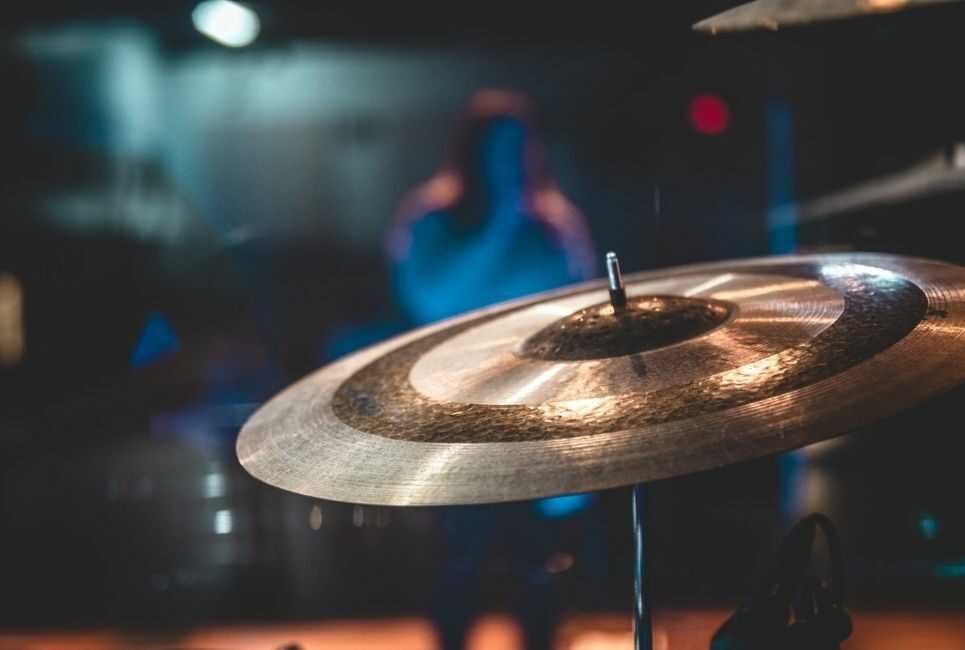- Lights, Camera, and Action: How to Film and Edit a Drum Cover - May 31, 2022
- The Best Wuhan Cymbals: A Comprehensive Buying Guide - May 30, 2022
- Alesis Surge vs Command Compared - April 26, 2022
Wuhan cymbals are held in high regard as some of the best cymbals money can buy. With their design, pitch, sound, price, and quality, you’re looking at something that will last you a long time and give you maximum creative control over your musical endeavors.
This might come as a surprise, but nearly all drummers go through disillusionment when scouring the drum market for the first time. I have encountered many products with varying quality and prices over the years and yet fumble when picking out new gear or upgrades. And while a few of them were worth it, some are ridiculously overpriced.
The Wuhan-produced cymbals are instantly identifiable for quality and are renowned worldwide. Their manufacturing techniques heavily rely on the fusion between modern-day technology and old-school wisdom. In turn, they’re able to produce timeless, classic – but also cutting-edge – drumming gear.
Whether you’re a beginner to drumming or you’re already an expert, a good set of cymbals are essential to your process. Therefore, the way you choose your cymbal will vary. There are several factors to keep in mind when choosing your cymbals, and I have looked at several options at varying pitches and prices that could help you on your purchasing journey.
The Bottom Line Upfront: Both the Wuhan 457 and Western series cymbals offer a great deal of value to drummers, but if it were up to me, I’d side with the 457 pack any day. The sound, aesthetics, and overall tonal flexibility offered by the 457 series cymbals are simply unmatched. That said, if you were looking for a professional cymbal set that delivers on every end, go with the Wuhan KOI series.
What Exactly Are Cymbals?

Cymbals are thin, round, and concave percussion instruments, much like bongos, gongs, bells, rattles, and tambourines. As some of you might know, percussion instruments help to add rhythmic elements to your music, and they are also one of the oldest man-made musical instruments ever.
Cymbals are typically categorized based on:
- Dynamics (crash, ride, and hi-hats)
- Dimensions
- Type of metal used for construction
Based on those factors, cymbals can be implemented across various drum kits and musical styles. Bigger and thinner cymbals produce deeper sounds, while thicker cymbals produce a higher pitch. Cymbals can either be used as a pair to strike together, or they can be used to expand the sounds of acoustic drum kits.
Furthermore, cymbals are made from different alloys, but they’re usually crafted from copper and brass. They are an indispensable part of any orchestra, especially jazz, classical, and rock music. Their size can vary between 13” to 18”, depending on the dynamics and feel one is aiming for.
The Different Types of Cymbals

Based on their applications, cymbals can be classified as:
- Crash: As the name suggests, this type of cymbal creates an explosive, crash-like sound when struck by drum sticks. The sound has a shorter decay time, which allows it to be paired with bass drums during breakdowns and tense changes in music.
- Hi-hat: Hi-hats come in pairs mounted together and are usually the smallest in the bunch. They can be triggered either via a foot pedal or drum sticks. One of the most popular methods of playing the hi-hats is opening up the cymbals with the pedal, letting it ring for a little bit, then closing it again.
- Clash: Not to be confused with the aforementioned crash cymbal, these are usually found in pairs. There are different ways to play them, such as “sizzling” (by rubbing them together), crashing them into each other, “scraping” the edges together, or even simply tapping them lightly together to produce a softer sound.
- Splash (Or “Effect” Cymbals): Splash cymbals are much smaller than your average cymbal, ranging from 6” to 13,” and some of them are as small as 4”. When struck, they create high-pitched, metallic sounds in short bursts, and they have to be hit quite hard to achieve that. Some common types of splash cymbals include the China, the salsa, the thin, and the bell cymbal.
How To Pick The Best Cymbal For You: Construction and Deciding Factors

Before picking the best cymbal, there are several factors you need to keep in mind. Let’s first take a look at the cymbal itself, though, and what it is made from. After all, the shape of the cymbal plays a big part in its sound.
There are 4 basic elements:
- Hole: Perforated cymbals are definitely a new trend, where manufacturers create holes on the surface to add unique character to the sound.
- Bow: The bow is what’s left of the cymbal around the bell, which tends to be the thickest near the middle and gradually thins out towards the edges.
- Bell: The bell is the center dome-like part of the cymbal, which produces a higher sound than the rest.
- Edge: The area closer to the bell is called the “ride” area, and the area closer to the edge is called the “crash” area.
If you are looking for a full-spectrum sound, go for cymbals between 14 to 16 inches across, with a medium thickness. This will output a sound for you that’s rich in harmonics but may also prove to be challenging to control the sound, especially when muting.
If you’re into jazz music, you’ll want thick cymbals with a stiff response. These can take power hits, but it also won’t be diluting the harmonics on softer hits. On the other hand, if you’re playing something less aggressive, you’re better off getting smaller and lighter cymbals.
Lightweight cymbals with a small circumference deliver a staccato sound, something which is highly desired by both the heavy metal and rock community. However, if you are going for an open and boomy crash sound, then thick perforated cymbals are the way to go.
Other Factors To Consider When Buying A Cymbal
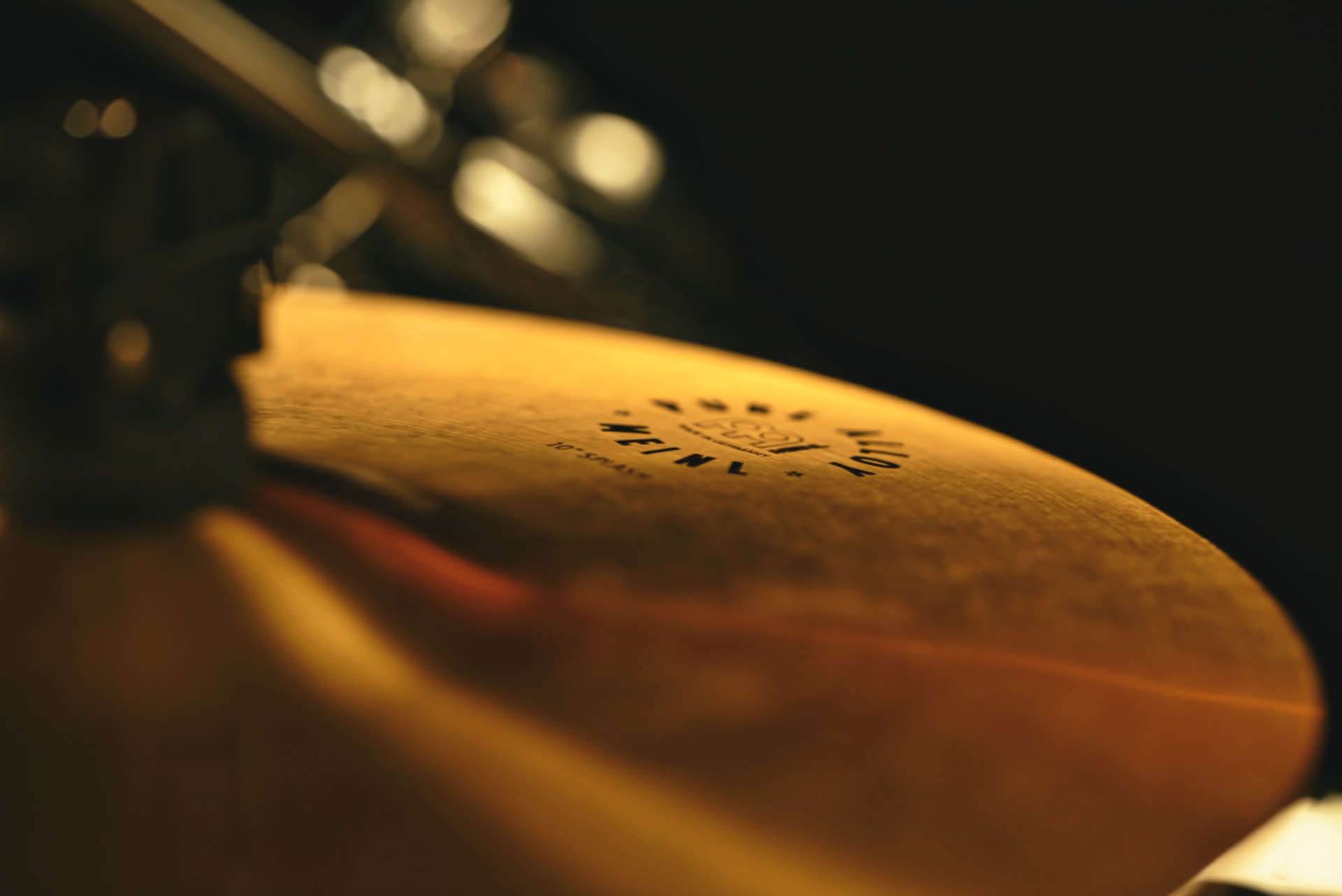
- The Quality: Brass cymbals are cheaper and good for newbies, but unfortunately, they’re not sustainable enough for extensive or professional use. If sound quality and durability are your top priority, then bronze is what you’re looking for – especially B20, which has a high percentage of copper and produces a rich sound palette.
- The Finish: You have two options with the finish: brilliant and traditional. Brilliant finishes are shiny with bright, clear sounds and are mostly used by multi-instrumentalist bands or orchestras. Traditional or neutral finishes are duller and look more worn and tough. The neutral finish produces a darker, less-refined sound.
- The Price: The price tag of a cymbal is affected by all the factors we’ve mentioned so far. A high price tag does not always mean higher quality; however, some cymbals manufacturers do like to sport bigger price tags due to their popularity. Brands like Wuhan can be construed as an affordable brand that is accompanied by high quality.
Best Use Tips for Drummers

If there’s one thing you must know before getting into drumming, it’s that handling and maintaining drum kits can be a tedious task. From tuning to keeping critical intersections lubricated, there’s much to keep in mind when it comes to taking care of drum gear.
Here are some quick expert tips that can help you get the most out of your cymbals:
- Don’t mount your cymbals on metal stands directly without using a cymbal sleeve or felt. This will ensure that the metal-to-metal contact will not wear out your cymbals at a faster rate.
- Make sure to never over tighten your cymbals as it will damp their sound, and in worst-case scenarios, crack them around the bell area.
- Angling your cymbals the right way is essential for extracting the full spectrum of your cymbals. Make sure they are mounted above eye level and angled towards you.
- If you plan on storing your cymbals for a while, make sure to use a cymbal bag or case to minimize damage from accidents and environmental factors like humidity.
- If possible, set up your drum kit in a place with low humidity, as it will slow down the oxidation process of metal parts.
- When playing, make sure to strike the cymbals with a reasonable amount of force. The most common cause for cymbal failure or damage arises from stress caused by accentuated swings by excited drummers.
The Best Wuhan Cymbals: Thorough Reviews
Wuhan cymbals create some of the most dynamically balanced cymbals at an affordable price for drummers. Whether you’re just starting out, or you’ve already gone far enough into your career to be in the market for something nicer, this review will definitely help you build more context around cymbals in general.
Wuhan 457 Cymbal Pack

The Wuhan 457 Rock series is a handy and hassle-free cymbal pack to start out with. It features the following three cymbals:
- 14” Hi-hats
- 16” Crash cymbals
- 20” Dark ride cymbals
They are purpose-built to provide subtle dark and dryish tones. Even though it was mainly designed to serve beginners and student drummers, Wuhan has made no compromises on the quality front of it.
Some of the most seasoned drummers have been known to use this particular cymbal pack as part of their practice kit. The cymbals are made from B8 bronze, which is 92% copper and 8% tin. This makes up for a durable compound while still delivering a muffled and scooped sound to drummers.
The best cymbals are hammered by hand, and the 457 pack is no exception. Their sleek and brilliant finish allows them to be easily paired with every drum skin out there. The well-rounded tone of the Wuhan 457 Cymbal pack makes it a perfect fit for jazz, rock, contemporary, and even some EDM styles of music.
Pros
- Affordable price point
- Decent sound quality and durability
- Tonal qualities are fit for various musical styles
Cons
- The cymbals are pretty dark in nature, which might not flow organically with bright-sounding drum kits.
Wuhan WUBTSU Western Series
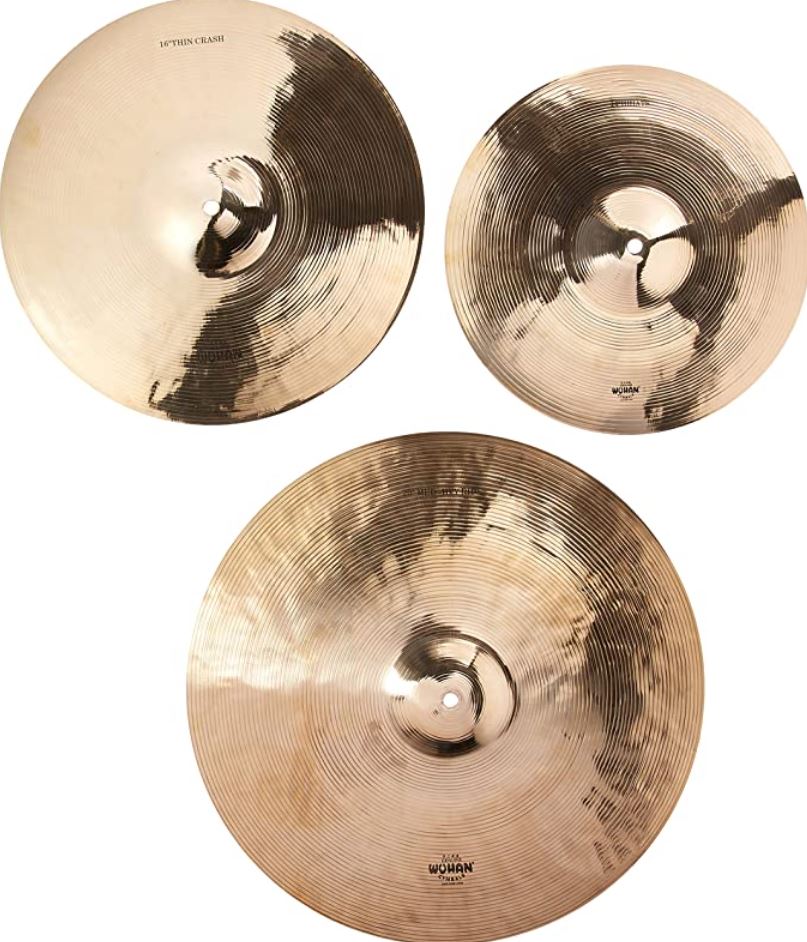
Similar to the 457 set, the WUBTSU pack is built for darker sounds but with richer overtones and harmonics. Even though it’s a bit of a jump price-wise, it’s still worth the investment if you are looking for a flashy cymbal set with a versatile tone. This series offers various cymbals in multiple sizes, such as:
- Splash cymbals (6” – 12”)
- Hi-hats (10” – 25”)
- Thin crash (13” – 19”)
- Medium thin crash (13” – 19”)
- Crash cymbal (13” – 19”)
- Crash/ride cymbals (20” – 22”)
- Linear smash cymbals (16” – 22”)
The WUBTSU pack cymbals are made from B20 alloy, which is 80% copper and 20% tin. Similar to the 457 pack, these are also hand-crafted for the best sound quality and tone. The finish is eye-catching, which makes it easier for drummers to pair them with their favorite drum kits without losing out on aesthetics.
Wuhan offers a diverse selection of cymbals in the Western Series based on size and thickness. In turn, this creates a world of possibilities for drummers to mix and match cymbals in order to get the desired sound.
Legendary drummers like Neil Peart, Jeff Hamilton, and Mike Terrana have relied on Wuhan cymbals for their signature sound in the past and are beyond satisfied with the results. The set even comes with a free cymbal bag so you can lug your kit around easily.
Pros
- Rich and dynamic sound
- Built to last
- Lots of options in terms of size, thickness, and tonality
Cons
- Slight inconsistency with double strokes or when playing fast
- However, these issues are a drawback of most hand-made cymbals
Wuhan ORA Series
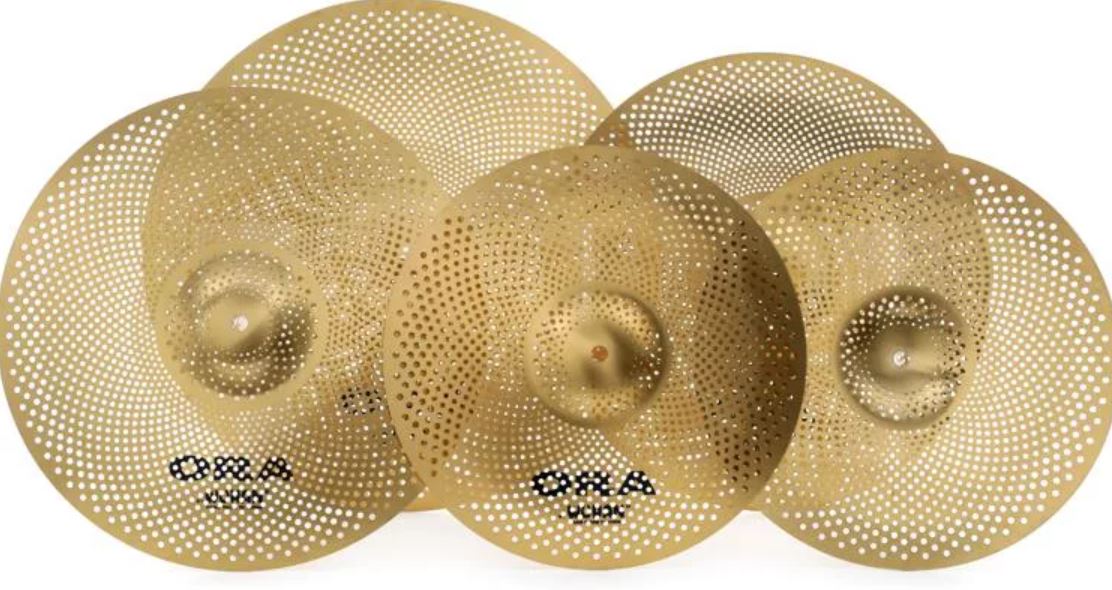
The ORA (outward reduced audio) series from Wuhan brings forth all of the drummer’s favorite collections of bright cymbals in an apartment-friendly format. The Wuhan ORA 4-pack features four perforated cymbals that have been tuned to yield reduced output, whose dimensions are as follows:
- 1 x 14” hi-hats
- 1 x 16” and 1 x 18” crashes
- 1 x 20” ride
The Wuhan ORA cymbals manage to retain much of the sway and dynamics of traditional cymbals, making them a great fit for garage sessions and bedroom jams. That’s not to say that these can’t be used for gigs, as their tonal qualities will suit a variety of musical styles, including RnB, jazz, and hard rock.
The finish may leave some drummers asking for more, though, as perforated cymbals are not everybody’s cup of tea. However, if you were looking for long-lasting reduced output cymbals, you cannot go wrong with the Wuhan ORA series.
Pros
- Players have tremendous control over the volume and dynamics of their cymbals
- Great for small-scale gigs and in-house sessions
- Flexible tonality
Cons
- Crash cymbal is between half and 1/4th as loud as traditional crashes
- Some users complained of a high pitched ring (which can be annoying to fix)
Wuhan KOI Series
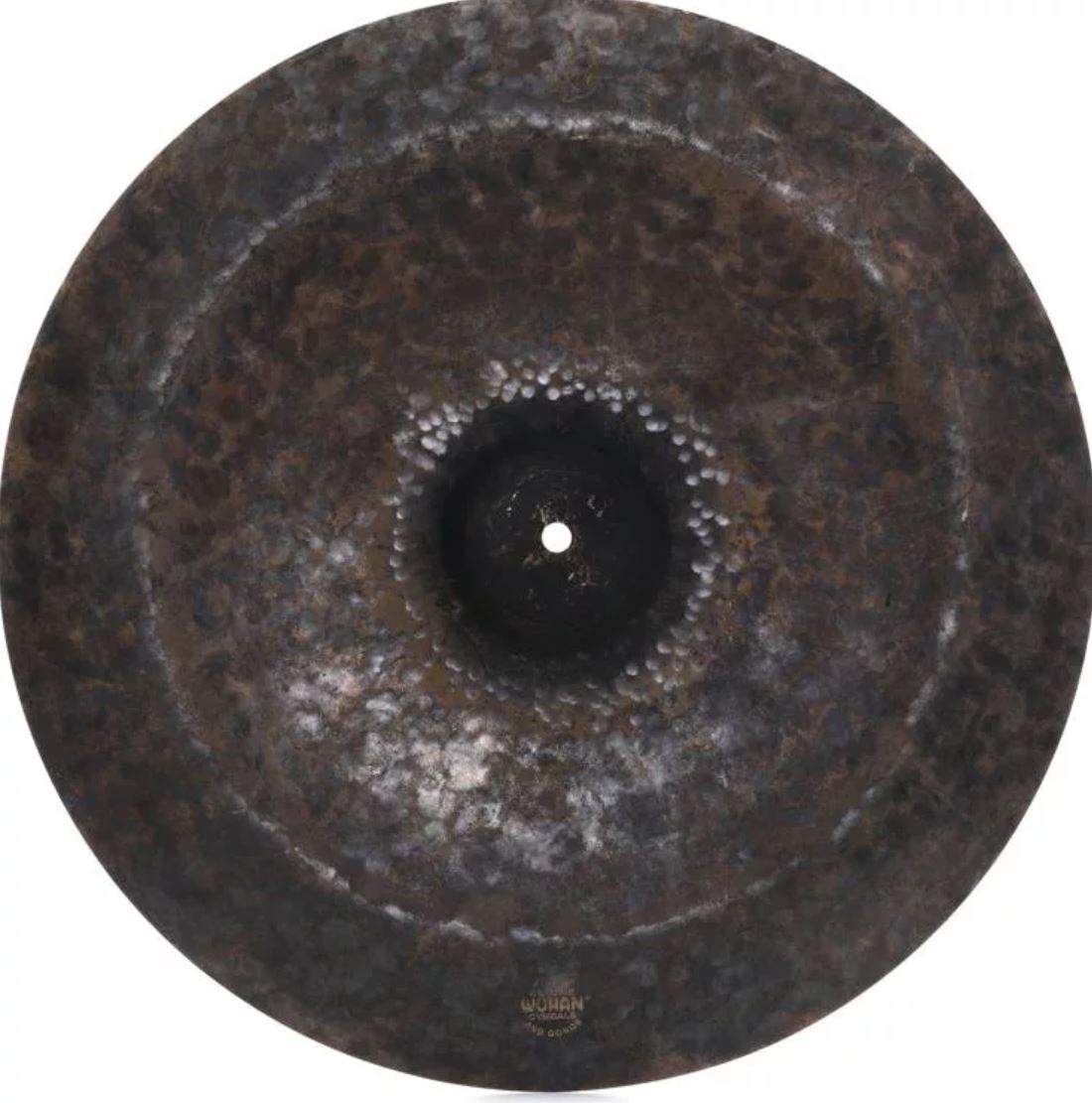
Rocking one of the most peculiar finishes in the cymbal world, the Wuhan KOI series has been turning heads for a while now. They have been designed to cater to professional-grade musicians without mounting exorbitant price tags.
Wuhan has made the following cymbals a part of the KOI series, which are available in different sizes:
- Conical China (20”)
- Crash (17” – 20”)
- Ride (21” and 22”)
- Hi-hats (14” and 15”)
The KOI series also features the one and only Conical China cymbal made by Wuhan. Made from B20 alloy, which is pretty much a staple in all high-end cymbals, it makes up for an explosive and yet musical-sounding cymbal.
The ride cymbals have a slightly flat response but a much larger spread than traditional cymbals. The bell carries quite a distinctive sound, which seamlessly pairs with the ride for a pronounced experience.
The KOI series makes it easier for drummers to get studio-quality sounds in their personal setup without breaking the bank. The value proposition offered by the 18” KOI is every drummer’s dream, especially when other manufacturers are easily crossing the $500+ line.
Pros
- Crash cymbals have brilliant overtones
- Affordable price tag
- Ride cymbals provide a smooth and flat response, opening up a lot of room for customization
Cons
- Conical China is a genre-specific pick, which may not mix well with other musical styles
- The finish is fairly unusual but not a complete dealbreaker
My Top Picks
When you have a mountain of options to pick from, things can get a bit tricky. That said, when it comes to Wuhan Cymbals, you can be assured of reliability and peak performance. Depending on the diverse demographic of drummers we have these days, I decided to pick three products that speak volumes to the crowd:
1. Wuhan 457 Cymbal Pack
There’s not many cymbal packs out there that cater to the novice, which is why this is my top choice for beginners as well as intermediate players. Wuhan’s decision to go for a less glassy tone with more mid-range makes it easier for novice players to experiment and learn the rudiments of drumming.

On the other hand, they have also placed the 457 cymbals pack in an economical category so more players can try their hands on these cymbals and achieve results that are very close to some high-end products on the market.
If you are simply looking for a practice set to spend your pent-up energy on, the 457 cymbals pack from Wuhan is strong enough to handle some of the worst abuse. You can either sport it on a mid-range drum kit or build a new setup altogether; there is no right or wrong way of handling such things.
2. Wuhan WUBTSU Western Series
When players are looking for something in the professional league of cymbals, the WUBTSU cymbals stand out for multiple reasons. Not only are you getting a lush [palette of dark sounds with dynamically rich overtones, you are not breaking the bank while doing so.

The Wuhan WUBTSU series offers quite a versatile tone that can be embedded into multiple musical styles and projects. Their inclination towards a raw and natural sound makes them a popular pick amongst Rock, Jazz, and even some metal players.
3. Wuhan KOI Series
When you need a lot of room for post-processing and adding effects to your drum sounds, you will have to depend on a dry tone which could be a challenge for many cymbals these days. The KOI series also offers a rich variety of perforated cymbals and is the only conical china created by Wuhan.

Although the price of this cymbal pack is only reasonable for studios and professional drummers, it also offers a lot of value to the regular joe. The intended flat response of KOI cymbals makes it easier for mixing engineers and even drummers to shape their sound appropriately in the mix. However, you will notice the lack of volume on the stage since perforated cymbals seem to dilute the sound to achieve that accentuated response curve.
Frequently Asked Questions
Answer: Wuhan cymbals are not cheaper because they use lower-quality materials, but more because of the country of origin itself: China. Labor in China comes at a much lower cost than in other cymbal-producing countries, so the production process becomes much cheaper.
Wuhan also prioritizes production over advertising and marketing, which cuts its expenses by a fair margin. Despite their lower price tag, their B8 and B20 alloys are still top-notch, and their brilliant finishes are up there with any other manufacturers.
Answer: Cymbals can last anywhere from 5 to 10 years, depending on their quality and the abuse they have been subjected to. The harder you strike them, the bigger the chances of developing spider web cracks on them. However, there are some tricks you can follow to make your cymbals last longer.
First of all, the way you play the cymbal can be detrimental. If you’re hitting them straight down instead of swiping a little bit, you can risk cracking them. In order to avoid this, try to hit the bow and swipe to the side.
The positioning of the cymbals is also important. Instead of mounting them straight to your position, you should have them at a slight angle towards you. This ensures that you don’t strike the edge, which can crack it.
Finally, tighten the wing nut up top but not too much. Leaving it a hair loose will make it move better and prevent cracks.
Answer: I’d say somewhere close to 16” is a good starting point if you’re a beginner. Is there a one-size-fits-all situation? Not really. Once you’ve dug beneath the surface and are certain about the sound you are looking for, your choice for cymbals will start to revolve around factors like harmonics, frequency range, feedback, and other dynamics.
Answer: Even though striking cymbals seems simple enough, it does have its own special techniques. As mentioned above, you need to swipe the stick instead of striking it head-on. Despite that, they are still quite easy to learn once you get the hang of the basics. There are three basic techniques:
The flam stroke
The sizzle stroke
The slide stroke
The most important part of playing the cymbals is positioning your body correctly. Producing the sound itself is quite easy, but mastering the body and arm movements is the tricky part. Like all things, of course, it takes time and practice to master this art form.
Answer: Brass cymbals are often marketed for beginners, but their quality is actually quite low. They simply don’t produce the best tone, and they are not sustainable. Instead, the B20 and B8 bronze alloys are what you really need.
My Final Thoughts
Cymbals, without a doubt, carry one of the most unique and versatile sounds in the percussion family. They offer an impressive range and dynamic control, which can be embodied in a number of musical genres. The Wuhan 457 and WUBTSU cymbal packs are ideal for beginners and intermediate players alike. They offer a wholesome sound without breaking the bank.
If you’re thinking about getting yourself a cymbal pack, make sure to consider most – if not all – of the decision-making factors we discussed today to get the best results. Even then, there is no telling what could end up wooing you or your bandmates in the end.
To avoid such a conundrum in my own musical journey, I always made sure to try out any musical gear before buying, be it at a music store or after borrowing from a friend. This will help you eliminate options that don’t align with your sound, but most importantly, it will also train your ears to better catch the sound in your head.

